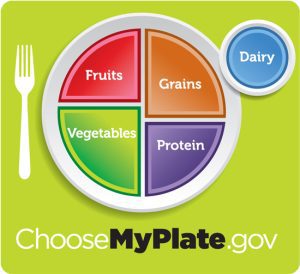People are eating more, moving less, and getting bigger. While genetics are important in assessing your risk of getting breast cancer, your weight is an important factor too. And it’s a factor you have some control over.
After menopause, the main source of estrogen is fat cells. The more fat cells, the more estrogen your body will produce, which could increase your risk of breast cancer. It’s a very compelling reason to keep your weight within normal range.
What Is Portion Distortion?
Portion Distortion is the trend over time of increasing food serving sizes. This is especially prevalent in restaurants and in convenience foods. According to Weight Watchers, 30-50 years ago, plates were only 9 inches in diameter. Now they are usually 12 inches across. Check out the documentary Super Size Me which explains this alarming trend in fast food restaurants. (Watch the full movie here.)

Portion Control Tips
- Use a smaller plate. Psychologically, we like to see our plate full. When you look at your plate, if it’s smaller, less food will make you feel the same level of satisfaction. Use a luncheon plate instead. Special portion control plates are even sold with food groups marked, similar to the USDA MyPlate guidelines.
- Say “No Thank You” to the Supersize Question. It’s not harmful to go through the drive-through every now and then. But order the regular hamburger and small drink. Better yet, skip the soda and ask for water!
- Try the Kid’s Menu. No one has to know you’re ordering for yourself.
- Try the Senior Menu. If a server resists because you are not senior age, offer to pay the full size rate and explain you simply want the smaller portion size.
- Don’t Buy “Family Size” Packages. Family-sized packaging is another way to experience portion distortion. Our human brain looks at a package of something big as not more servings, but bigger servings. If you want to capture the cost savings of say, a family pack of chicken breasts, individually freeze them when you get home. This will subconsciously prevent you from cooking (and eating) a whole pack when you’re only serving one person.
- Split It. Share a restaurant plate with a friend. You’ll save money and calories. Most restaurants will even give you an extra plate if you ask.
- Ask. Sounds simple, but try asking for a smaller portion. Quite a few restaurants have smaller portions of popular menu items that they don’t advertise. The most famous example is the Starbucks short cappuccino. They may even be able to alter another menu item to fit your needs or give you a suggestion for something similar but smaller.
- Ask for A Doggie Bag Ahead of Time. Having food on your plate can be a temptation. Be strong—ask your server to box up half the entree before bringing your meal to the table.
For get more healthy eating tips, subscribe to our newsletter!
